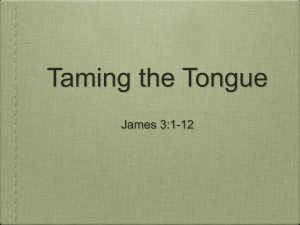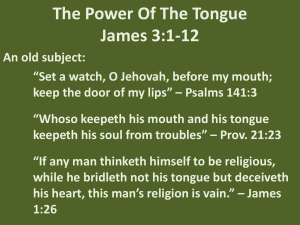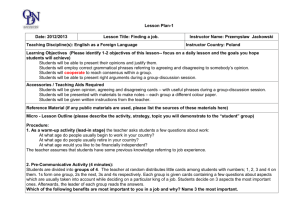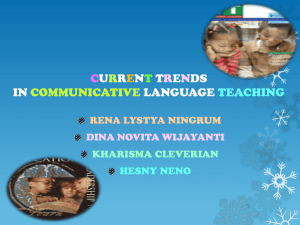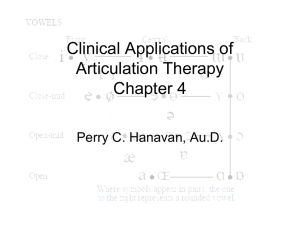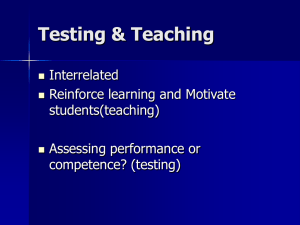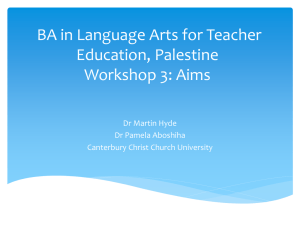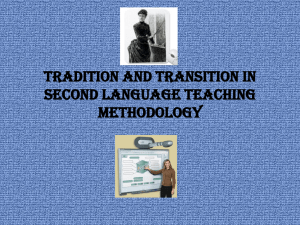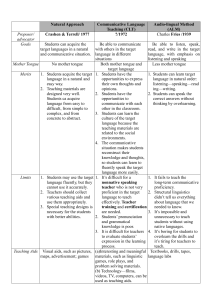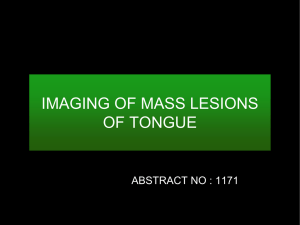Communicative Approach Power Point
advertisement
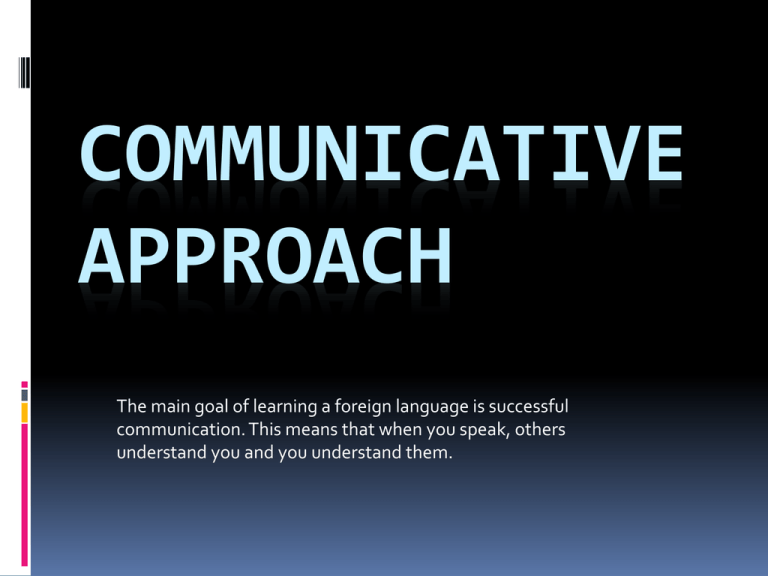
COMMUNICATIVE APPROACH The main goal of learning a foreign language is successful communication. This means that when you speak, others understand you and you understand them. The language I have learnt these forty years, My native English, now I must forgo, And now my tongue’s use is to me no more Than an unstringed viol or harp. Or like a cunning instrument cas’d upOr being open put into his hands That knows no touch to tune the harmony. Within my mouth you have engaol’d my tongue, Double portcullis’d with my teeth and lips, And dull unfeeling barren ignorance Is made my gaoler to attend on me. I am too old to fawn upon a nurse, Too far in years to be a pupil now. (Shakespeare: Richard II, Act 1, Scene 3) •Because of his age, Mowbray feels that he will never again be able to express himself in a new language to the same degree that he was able in his native tongue. Objectives To gain a better understanding of the main approaches, language teaching methods and techniques associated with them. To become more aware of current views on communication, language, and language learning. To be able to make informed choices of modern methods and techniques appropriate for their teaching situation. History Grammar Translation Method In the middle of the 19th century, modern languages taught in the way Latin and Greek were taught, language viewed as a system of rules, theory of learning-didactic (jug & mug). Goalacademic knowledge about language, literature, philosophy, language learning is a means of mental training. Direct Method Appeared in the 1920s as a response to growing trade and international contacts. Based on no single theory of language, through the development of phonology contributed to its appearance. Natural theory of learning (like a child learning Mother tongue) through direct association of foreign language and objects. Its goal is rapid practical command of a language. Audio-Lingual Method Made its appearance in 1950s, resulting from the need for a more intensive method to teach foreign languages. Based on the structuralist view of language and behaviorist learning theory (stimulus-response). Learning is habit-formation through repetition and positive reinforcement. Goad- to master the whole language, to present the learners with an accurate model of the language. Communicative Approach The communicative approach appeared in the early 1970s as a reaction to criticism of audio-lingual method with its limited view of language and learning. The major developments in Theories of Languages - shift from the structural view of language to the emphasis of the viewpoint that language is a means of communication in the first place. Cognitive code theory: learning is not just learning of habits, but also an active mental process. Learner is responsible for learning and using a language. Second language acquisition theory: emphasis is on comprehensible input-language is acquired by understanding messages. Language learning comes through using language communicatively. Grammar Translation Direct Method Audio-Lingual Communicative Approach Typical Exercise Types •Writing translations •Memorizing •Questions &Answers •Describe a picture •Imitation •Drills •Substitution tables •Dialogue memorization •Information-gap •Problem solving •Role playing •Simulations Role of Teacher •Dominant •Source of info •Ultimate authority •Model to be followed and imitated •Provider of stimuli and reinforcement •Drill-master •Facilitator •Informant •Consultant •Manager Attitude to Error •Negative •Must be immediately corrected •Seen as students’ carelessness •Accuracy is to be achieved •Teacher provides students with a chance to self-correct •Attempts all to avoid mistakes •Mistakes form wrong linguistic habits •Learners encouraged to take risks •Errors are inevitable, they are learning steps. Attitude to Mother Tongue •Mother tongue used for instruction, explanation, comparison, and translation. •Little use of mother tongue •Translation is outlawed •Mother tongue avoided •Mother tongue used occasionally, when necessary Criticism of Method •Little experience in speaking •Lack of comm. skills •Underestimated role of reading and writing •Counterproductive prohibition of mother tongue •Meaning is often irrelevant •Lack of flexibility •Overestimated role of drilling •Lack of accuracy due to focus on fluency Method Strengths •Strength in knowledge of Grammar Rules •Strong emphasis in reading and writing •Strong in listening and speaking •More natural and similar to learning mother tongue •Strong in speaking and listening •Repetition and reinforcement good for certain learners •Integrated approach •Promotes higher motivation •Real communication Research Learning another language may be the most ubiquitous of human intellectual activities after the acquisition of the mother tongue. It is therefore not surprising that research in this field has become one of the exciting frontiers of cognition science. Theory The need for meaningfulness in language learning has been accepted for some years. A useful interpretation of ‘meaningfulness’ is that the learner respond to the content in a definite way. If they are amused, angered, challenged, intrigued, or surprised the content is clearly meaningful to them. Thus the meaning of the language they listen to, read, speak, and write will be more vividly experience and, therefore, better remembered. Practical Application Administrative Considerations Logical Considerations Instructional Considerations Needs Assessment Psychological Considerations Learning Objectives Methodology Method Approach in Design Procedure Materials Program Design Evaluation Practical Application Cont’d Questions of immediate concern will focus on who the learners are, what their current level of language proficiency is, what sort of communicative needs they have, the circumstances in which they will be using English in the future, and so on. Curriculum development requires needs analysis, development of goals and objectives, selection of teaching and learning activities, and evaluation of the outcomes of the language program. References Books: Communicative Approach: Betteridge, David; Buckby, Michael; et. Al. Games for Language Learning. Cambridge University Press. 1993.- Complete Text Littlewood, William. Communicative Language Learning. Cambridge University Press. 1981.- Chapter 3 Communicative Activities. Richards, Jack C; Rodgers, Theodore S. Approaches and Methods in Language Teaching. Cambridge University Press. 1986.- Chapter 5 Communicative Language Teaching Testing: Bachman, Lyle F. Fundamental Considerations in Language Testing. Oxford University Press. 1990.- Complete Text Spolsky, Bernard. Measured Words. Oxford University Press. 1995.Complete Text Internet Links: www.apenglishlanguage.org www.homeworktips.about.com http://www.philselfsupport.com Conclusion It has been said that teachers who have been teaching for twenty years may be divided into two categories: those with twenty years’ experience and those with one year’s experience repeated twenty times. In other words, sheer time on the job does not ensure fruitful experience and professional progress. Successful teachers are those who continue to develop throughout their professional lives.

